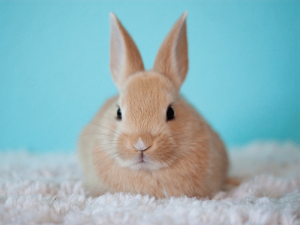An estimated 1.5 million rabbits are kept as pets in the UK. They are increasingly popular, no doubt for their sweet, amusing personalities and, what some might be surprised to hear, their surprising ability and willingness to learn and to be interactive members of the family. Awareness of the best way to care for rabbits is on the increase. From the requirement to keep them with at least one other rabbit, to their complex dietary needs, bunnies are being cared for better than ever. And yet there is one issue, one agonising problem that rabbits continually come to us vets with, and that is fly strike. Fly strike is an unpleasant, painful and sometimes fatal condition that, tragically, is often only noticed once it is well developed. We can help you to recognise the early signs, and to make some very necessary checks for this awful disease.
First it’s helpful for you to know what fly strike is (technical term for fly strike is myiasis), and it really is just as its name describes. The green bottle fly seeks an environment to lay its eggs. The perfect environment is one which is warm and preferably with a ready food source. Bunnies, as well as other animals such as sheep, commonly fit the description, especially if their rear ends are covered in faeces or urine, as the odour attracts the fly.
Having been laid upon the rabbit, eggs develop into maggots, which in turn feast upon your bunny’s flesh. It is as gruesome as it sounds and also extremely painful. The sooner we see these bunnies at the vets, the sooner we, along with our strong-stomached nurses, can painstakingly remove each maggot with special instruments. We will provide your bunny with pain relief, fluid therapy, and whatever else they might need for the best chance of recovery.
It is obvious then, that preventing this kind of suffering is far better than curing it. The first step in the fight against fly strike is to identify it early, so it’s helpful to know which rabbits are especially at risk.
Those with dirty derrieres is the best place to begin. It is vital that rabbit enclosures are cleaned out regularly, and this is especially true in the spring and summer months because a dirty environment will attract the green bottle fly. A large, suitably-sized enclosure is not only important for the mental well-being and physical fitness of a rabbit, but will also allow them to move away from dirty areas, keeping themselves clean. Given the chance, a rabbit is a clean creature, who likes to urinate and defecate in one area, and eat, play and sleep in another.
Another key risk factor for fly strike is obesity, due to low-slung rear ends dragging through faeces and urine, as well as the inability for overweight rabbits to get to the ‘hard to reach’ areas in order to clean themselves effectively. Ensuring an appropriate diet and keeping your rabbits in good, healthy condition can do wonders for preventing fly strike.
What’s more, an overly rich diet causes faeces to be soft, sometimes runny and therefore more likely to coat their fur. For example, you might be surprised to learn that 85% of a rabbit’s diet should be roughage such as hay or grass. For more information on the appropriate diet for your rabbit, and to ensure you’re feeding roughage, vegetables and commercially prepared pellets in the right proportions, please get in touch, we are more than happy to advise.
Another group of rabbits that are less fussy about personal hygiene are the aged. As a rabbit embarks on a slower pace of life, perhaps they are less inclined to move away from dirty areas in their enclosure. Arthritis is also a very real problem that can make it hard for rabbits to contort themselves in such a way as to allow themselves to clean every nook and cranny. Thus older rabbits are potentially more likely to be dirty and therefore are exposed to increased risks.
So as well as a clean environment, maintaining a healthy body weight and a good quality and appropriate diet, how else can we prevent fly strike?
Fundamental to the care of your rabbit is checking them from nose to tail regularly. Not only should you check for other parasites, cuts and bumps, the condition of teeth, rabbit owners also need to be checking their rear ends undercarriage every day. Checking for fly eggs, sores (another way-in for maggots) and cleaning away any muck is necessary.
It will have the added bonus of desensitising a rabbit to being handled, which will in turn make them a more sociable pet. Other signs indicative of fly strike include lethargy, anorexia and potentially a strong odour. Should you notice any of these signs, you should get in touch immediately.
There are topical treatments available for the prevention of fly strike and we highly recommend that you use them during the warmer months. Our preferred treatment is one that you apply to your rabbit every ten weeks and it acts as a repellent to flies – ask one of our vets for details of this prescription-only medicine.

